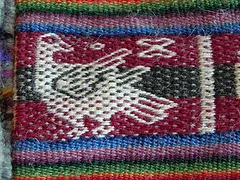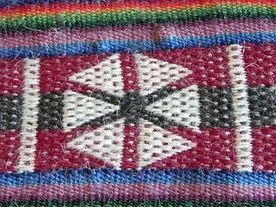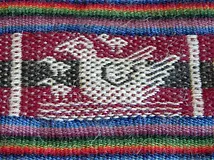PERU - Paracas Textiles & More
- WarmQuilts
- Aug 3, 2024
- 6 min read
With tears in my eyes, I stepped over piles of ash into what used to be my sewing room. Standing where my bookcase was located, was now about ten inches of grey-white powdery ash. Looking closer, a few items slowly came into view. The feathery pages moved ever so slightly, with quarter-sized pieces breaking off in the wind and disintegrating mid-flight. Did I see that right? Where did those translucent pieces go?
I carefully knelt down to see if I recognized anything, and wondered if I would be able to recover a small memento from any of my quilting keepsakes, travel journals, photo albums, or tools. It was all quite surreal.
The upright ashen forms were the paper pages of what had been on the shelves. While most were a milky white, there was one that still had the writing intact! I slowly read the words "innovations in textile", "Painted cotton", "Paracas" -- this was the Introduction section to a travel book on Peru (for a trip I took to The Sacred Valley in August 2015).

MACHU PICCHU: A girlfriend and I planned our trip but after damage from torrential rains in February 2010, we read that "the World Heritage Centre expresses its concern that the impact of the vast inundation of water has affected the water-carrying capacity of soils, provoking future landslides and fatalities in the core zone of the property. The full reconstruction of the road and trail, potentially creating uncontrolled access to the Sanctuary and impacting the outstanding universal value of the site, are also concerns." We informed our husbands that we would find another location for our travels.
Peru remained high on our list and in August 2015, we set out on our amazing, once-in-a-lifetime adventure. The beauty of the Sacred Valley, the unfathomable engineering feats, agricultural experimental practices still at work today and the enormity of the many ruins - there was so much to see and learn.
It was fascinating to learn that the textiles of ancient Peru were made by a people with an inordinate sensitivity to the complexities of structure, pattern, and color. Fortunately preserved through the centuries by the dry climate of the coastal region where they were interred, the fabrics retain much of this complexity today. Textiles discovered in the necropolis of Wari Kayan on the Paracas Peninsula in the early part of the century are particularly striking. Encompassing a wide range of garment type, they exhibit rich colors imaginatively combined, and compelling designs and imagery.
LARCO MUSEUM
Our visit to the Larco Museum was truly an enriching experience.

Founded in 1926 in the Pueblo Libre District, the museum displays remarkable chronological galleries providing an excellent overview on 3000 years of development of Peruvian pre-Columbian history. Located in a unique vice-royal mansion of the 18th century, it is built over a 7th century pre-Columbian pyramid and surrounded by lush gardens. The Larco Museum features the finest gold and silver collection from Ancient Peru. A room devoted to textiles was sourced only with ambient-light but taking photos was permitted.

Mochica-Huari Brocade: Textile (Coast of northern Peru) - Fusion Epoch (800-1300 AD)
This textile panel features figures shown with their heads in profile, carrying two scepter-like staffs used by leaders as a symbol of power.
It probably came from the Castillo de Huarmey (Ancash) site, on Peru’s central coast.

Nasca Embroidery: Textile (Coast of southern Peru) - Apogee Epoch (1 A.D. – 800 A.D.)
Material: Dyed camelid fiber yarn.
Technique: Embroidered loosely woven plain fabric.
This textile panel is decorated with figures carrying staffs and trophy heads.

Inca Quipus: Highlands of southern Peru - Imperial Epoch (1300 d.C. – 1532 d.C.)
Quipus are formed by a primary cord and hanging cords. They were usually made from cotton, although some were made from camelid fibers. Some quipus also feature knotted hanging cords and set distances between groups of cords which may have enabled the user to distinguish between different categories of data.
Quipus were the main system employed by the Incas to record information. The knotted cords were used to record countable information. The colors, knots and the distances between the knots enabled those who used the quipus to identify the type of object or the characteristics of the population being recorded. (READ MORE)

From the Museum's Website:
Textiles served as much more than clothing; they were also a medium for the spreading of religious ideas and for transmitting messages to the next world when they were employed to wrap the mortal remains of the dead. They also served as exquisite gifts for the rulers of these societies, as well as to denote social status.
In the Andean region, cotton was domesticated some 4,500 years ago and it quickly became one of the most important materials used in the processes of spinning and weaving and the production of fishing nets, bags, funerary mantles and fine clothing.
In addition to cotton, alpaca and vicuña wool was also woven. The wool from these animals is among the finest in the world and it protects the wearer against the cold as well as being highly impermeable. Today the clothing made from these materials is also greatly appreciated in the rest of the world. In ancient Peru the women usually spun and wove. They were experts in the techniques of spinning, dying, weaving and embroidering.
Textiles are capable of containing a great deal of information, not only in their designs, but also in their actual structure. The textiles of southern Peru are the most well-known, for they were preserved by the dry desert environment of the southern coast.
If you are interested in viewing more of these woven textiles, these colorful pieces are part of The Metropolitan Museum's collection from the Paracas culture:

Embroidered Border Fragment is dated 4th–3rd century BCE.
Dimensions: Overall: 5 1/2 x 15 3/4 in. (13.97 x 40.01 cm)

Embroidered Border Fragment is dated 4th–3rd century BCE.
Dimensions: Overall: 5 1/2 x 15 3/4 in. (13.97 x 40.01 cm)

Embroidered Fragment with Figures is dated 3rd–2nd century BCE.
Dimensions: Overall: 4 1/2 x 99 in. (11.43 x 251.46 cm)
PACHACAMAC SITE MUSEUM
Our visit to the pre-Inca ruins of Pachacamac is considered by many to be the most important archaeological site near Lima. Four hundred years before the Incas, the Ishmay culture developed a major ceremonial center, featuring streets, dozens of temples fitted with ramps and the Painted Temple. There is continual excavation at this largest archaeological site outside of Lima. The area is expansive with many excavated sections visible for wide-angle and zoom-in photography.




From the PeruTravel website:
Pachacamac, which means soul of the earth, the one who animates the world, is located about 40 kilometers southeast of the city of Lima. It is one of the largest archaeological sites, covering 465 hectares, and holds great significance in the region, boasting a historical legacy that spans three millennia.
This was a ceremonial and religious center inhabited by different pre-Inka cultures before becoming part of their powerful empire around the 15th century. It was inhabited from around 200 AD and flourished until the arrival of the Spanish in the early 16th century. Here, worship was offered to the god Pachacamac, one of the most feared gods in ancient Peru, believed to predict not only the future but also the movements of the earth and, in some cases, cause earthquakes.
Today, Pachacamac boasts a vast array of ancient structures, including temples, palaces, pyramids, aqueducts, cemeteries, squares, streets, among others, and a comprehensive site museum.
I opened the red go-bag. It was one of the last bags we placed in the trunk of the car as we evacuated during the August 2020 fire. This was one of the last bags that I have recently unpacked. The bag that contained a few items from my sewing room that had been rounded up if we ever had to leave the house in an emergency situation. I had placed a couple of completed quilt tops, some special fabric, some duplicate notions and a few travel souvenirs.

Peeking inside brought a big smile and happy tears. I found the note card - pieced artwork purchased outside of Lima, from the group of women with small booths set up at the site that was to become the Pachacamac Museum (inaugurated in February 2016). The archaeological site was enormous. The women co-op was the only splash of color in the entire area.
Some photos have gone missing as have my books, brochures and souvenirs. What an unexpected treat to find this modern note card safely tucked away; like my memories of the Sacred Valley of the Incas.
We developed an appreciation of the Incan society, their many accomplishments and their deep respect for Pachamama (Mother Earth) - what else could they have accomplished had they been left alone to flourish?
"Ama sua, ama lulla, ama chella." (Do not steal, do not lie, do not be lazy). ~Inca Golden Rules
Machu Picchu follow-up: Yes, on Day 5 of our trip, together with Bilma (our guide), we reached the entrance. Not everyone walking past us understood the significance of our tearful embrace. While crossing off another location to take their "selfies", being at Machu Picchu meant so much more to us - both spiritually and emotionally. Photos preserve the scenic images but these sacred Inca ruins will always remain in our hearts.
Thank you for stopping by.
XOXOX







This is lovely. Thank you for sharing such a rich and personal experience with us.